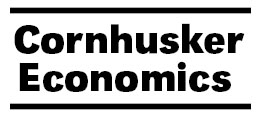Agricultural Economics, Department of

Cornhusker Economics
Date of this Version
2-22-2017
Document Type
Newsletter Issue
Citation
Cornhusker Economics February 22, 2017.
Abstract
Nationwide farm net income has fallen for the last three years and appears to be on trend to keep falling. Interest rates are likely to increase, as the economy seems to be warming up, resulting in increased borrowing costs and tighter credit conditions. Cash rents fell by nearly 11% on average-quality farmland in 2016 and are on a trend to continue in the coming year. In addition many farms have decreasing amounts of working capital to make up for declining incomes and high costs of production. The decrease in working capital if unchecked can decrease the stability of an operation. With no real signs that commodity values will increase and the unpredictability of the future this situation, while not dire, warrants watching.
Net farm income and working capital are vital to keep U.S. farms and ranches sustainable and healthy. While these two measures do not track the same thing, their measure of firm success and health are closely tied to each other. Net farm income (Profit) is the total earnings after expenses for the production year. This is reflected in the profit equation: profit = total revenue – total cost and is directly influenced by prices, productivity and costs. Working capital is the amount of capital an operation has remaining after subtracting the current 12- month liabilities from the current assets. Working capital is a way to measure an operation’s ability to meet its short-term obligations and handle risks.


Comments
Copyright 2017 University of Nebraska.